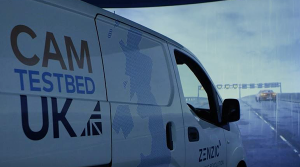CAM Testbed UK is a collection of six testing facilities working together to push the UK to the forefront of the self-driving testing and development industry globally. Core to this collaboration is what Zenzic calls Strategic Projects – driving further collaboration and interoperability across CAM Testbed UK. The projects look for opportunities to combine the capabilities and knowledge across the facilities to solve common problems and from that provide best practice out to the wider ecosystem.

One of our core projects for 2020-21 is Interoperable Simulation. It is widely recognised that the advent of increasing automation and connectivity in the automotive sector requires a far greater level of validation and verification. This cannot be achieved using the traditional approaches of physical testing and component simulation. The transfer of the driving task to the vehicle necessitates a vast and complex simulation capability to fully test the limits of the automated driving system (ADS). CAM Testbed UK has an array of simulation capabilities across its facilities, and our partner Smart Mobility Living Lab: London (SMLL) recognises the importance of this.
“Simulation is important for the development of connected and automated vehicle (CAV) technology and is especially important to SMLL as it can be used to de-risk on-road trials and support safety cases.
In addition, we also see simulation as a way of extending the testing conducted at the SMLL testbed, allowing customers to focus on specific functionality, perturb around scenarios experienced in a trial, or to test scenarios that aren’t possible to trial in a real public environment.
Ultimately, if the reality gap can be closed between the virtual and real environments, simulation could be used for virtual validation of CAVs which could dramatically reduce development time and costs.”
– Jonathan Clark, Technical Consultant, Smart Mobility Living Lab (SMLL)
Currently many ADS developers have their own capabilities in simulation or use a limited set of commercially-available toolchains. However, where third-party or additional simulation is needed organisations must designate efforts to integrate their own systems or software into specific tools. Where they may require special capabilities or multiple environments this can mean there is a lot of resource and cost allocated to multiple integrations. This presents a challenge to testing organisations. How do you provide a compelling set of virtual test capabilities which meet the customer needs? Similarly, the ADS developers have a challenge in deciding how much of their own in-house capability to develop.
“Understanding the customer’s needs is a critical factor in developing the right simulation and testing solution, but in an emerging space there needs to be a degree of demonstrating the ‘art-of-the-possible’ too. This can elicit customer pull or lead to important changes in the value propositions to them. It’s an iterative process working with innovation, for example in the development of highly automated vehicles, as most customers are themselves on a journey of discovery and not fully aware of their needs. This creates a challenge which is best addressed with a co-operative approach.”
– Gunwant Dhadyalla, Chief Engineer, Midlands Future Mobility (MFM)
This dilemma is what has driven CAM Testbed UK to look at interoperable simulation. In essence, the premise is that if we can allow a customer to access multiple capabilities and environments across numerous facilities with a reduced integration complexity, we will have solved these challenges. Customers get access to the best-of-breed across CAM Testbed UK and the testbeds themselves are able to offer more comprehensive test capabilities to their customers. This in turn accelerates the time-to-market for products and services for developers.
The Interoperable Simulation project team is currently pulling together an architecture which will deliver a proof-of-concept demonstrator, showcasing multiple testbed facilities working together in an interoperable fashion. We’re keeping the details under wraps right now, but David Kernohan, Programme Manager at Millbrook Proving Ground says:
“In this project we will design, develop and implement a distributed interoperable simulation environment, as a proof of concept (PoC), to provide a complete end-to-end simulation toolchain for test and validation of a range of AD scenarios and use cases, in collaboration with three selected CAM Testbed UK partners (Millbrook, SMLL and MFM) and StreetDrone as the customer, with support from global companies including Nissan, rFpro, IPG, PTV and RTI.
Through this novel project we will demonstrate various options of simulation interoperability, including Model Interoperability, Simulation Interoperability and Distributed Simulation (Co-Simulation) with the vision of building the foundation towards the development of a comprehensive distributed integrated simulation environment across CAM Testbed UK (and beyond) in the future, as defined in the UK Connected and Automated Mobility Roadmap to 2030.”
Zenzic is delighted to be working with StreetDrone to demonstrate a real-world use case in our demonstration event in March 2021. StreetDrone is a developer of an open-source automated driving system platform and has tested at multiple facilities in CAM Testbed UK already.
“StreetDrone is excited to be involved in such a cooperative effort to develop interoperability between CAM Testbed UK. There are real StreetDrone autonomous vehicles in deployment at both SMLL and Millbrook-Culham, with interoperable simulation providing a unique opportunity for developers to compare data and add to their system’s capability.
Simulation provides a critical, cyclical method of validation for autonomous technology. Interoperability between testbeds in simulation will allow developers to accelerate the progression of their technology stacks and bridge the gap between the virtual world and reality on the roads, leveraging the unique features that each testbed can offer. StreetDrone supports the use of Project Aslan, an open-source software stack for low speed self-driving, and hope this community-led effort will add valuable growth to this project. “
– Mike Potts, CEO, StreetDrone
We look forward to sharing more information with you as the Interoperable Simulation project develops. Sign up to our newsletter to be notified of these updates.


